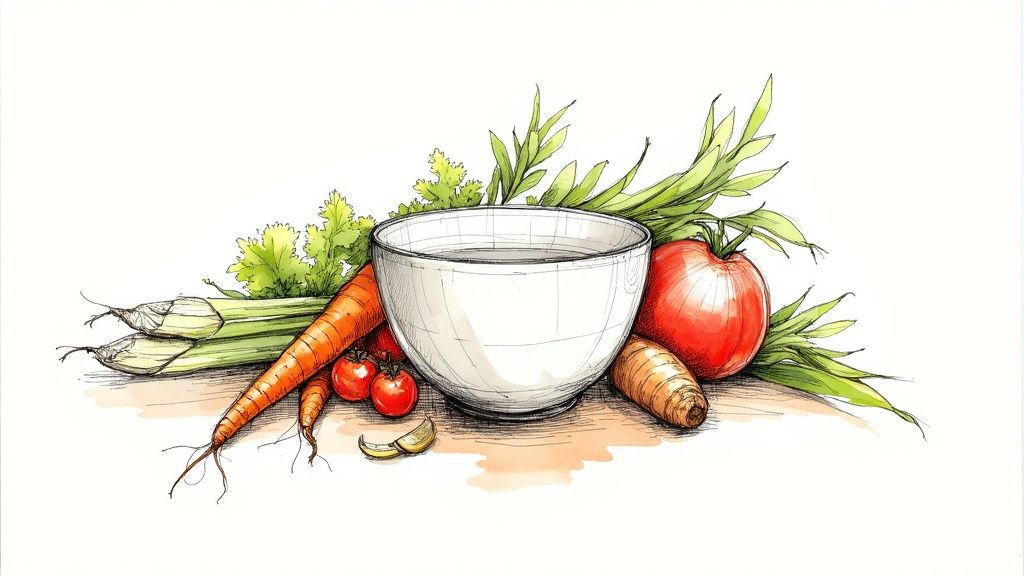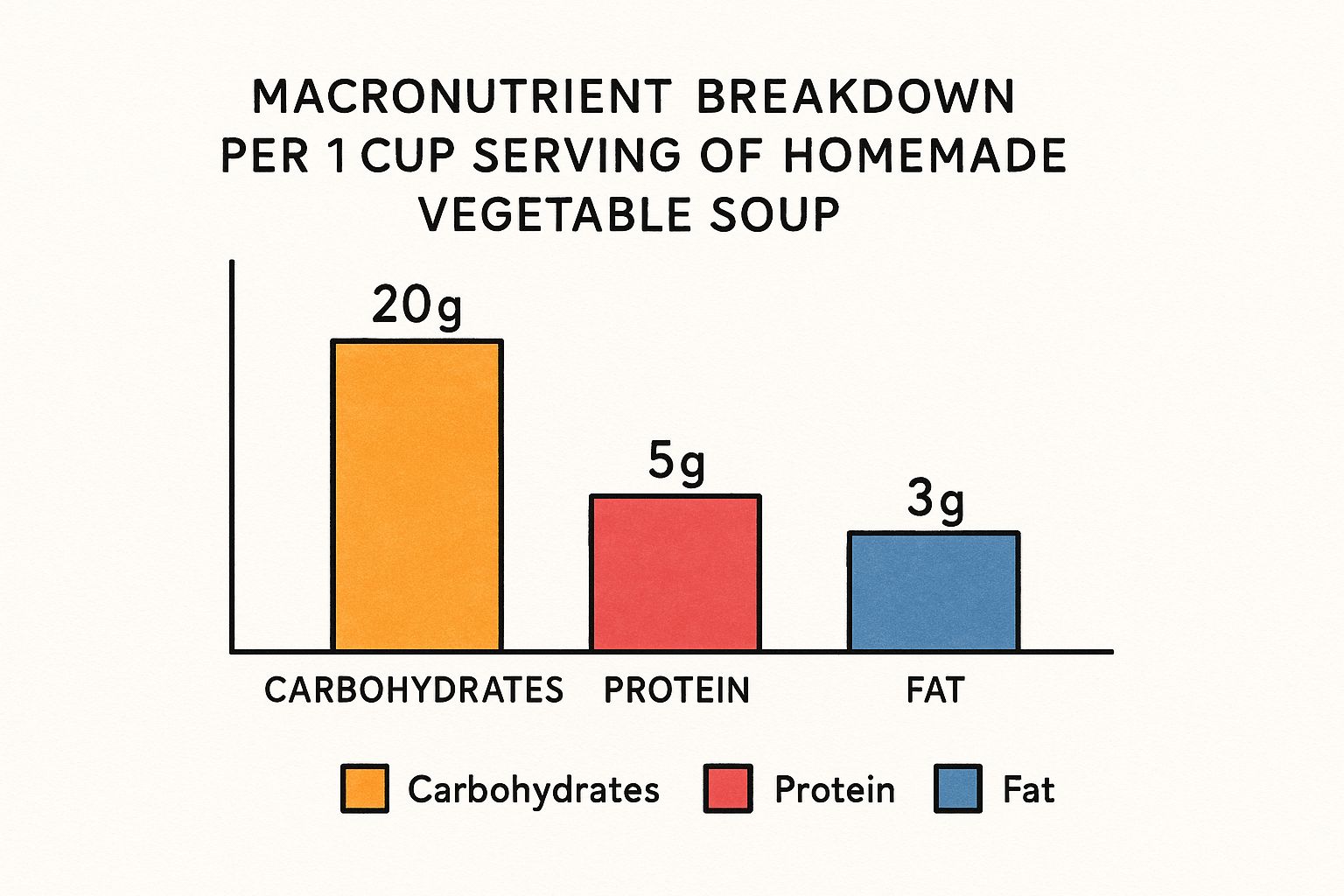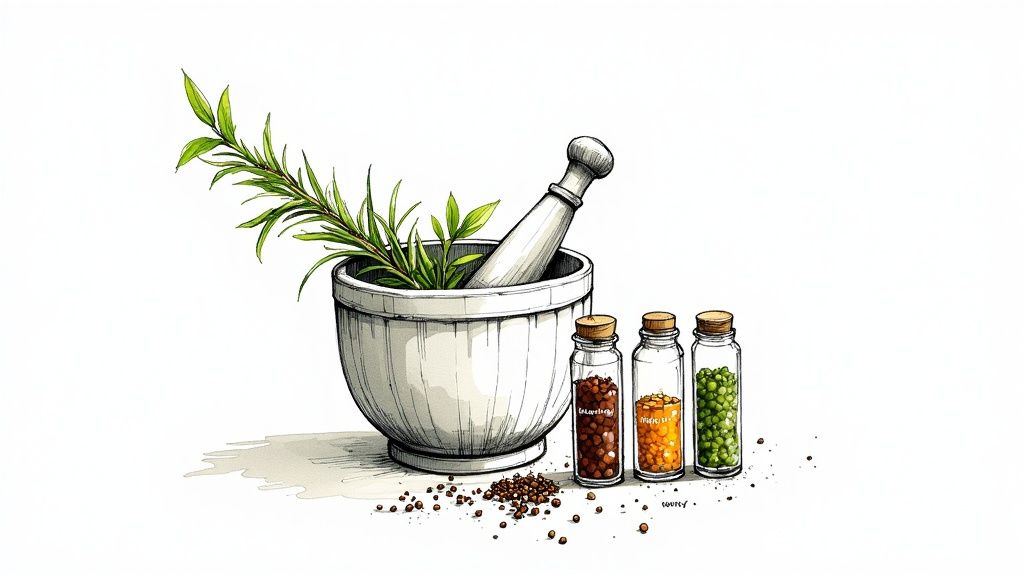Homemade Vegetable Soup Nutrition Facts and Tips
Unlock the secrets of homemade vegetable soup nutrition. Discover calories, vitamins, and how to easily track your healthy, delicious meals with voice.
Posted by
Ever wonder what's really in that comforting bowl of homemade vegetable soup? It feels healthy for a reason. Most recipes are super light on calories yet packed with good stuff, often clocking in at less than 100 calories per cup.
It’s the kind of meal that fills you up with vitamins and fiber from all the veggies, fueling your body without weighing you down.
The Real Nutrition in Your Cozy Soup Bowl
Let's get specific. When you ladle out a bowl of vegetable soup, what are you actually eating? Knowing the numbers isn't about being strict—it's about appreciating how powerful this simple dish can be.
For many of us, a bowl of vegetable soup is the perfect light lunch or a warm starter before dinner. Understanding its nutritional profile just makes it feel even better.
A Quick Snapshot of the Macros
So, what does a typical serving look like? While every recipe is a little different, a standard cup of homemade vegetable soup (about 245 grams) is surprisingly lean.
On average, you're looking at around 66 calories. That same serving usually has about 1.1 grams of fat, 2.1 grams of protein, and 12 grams of carbs. It’s a classic high-volume, low-calorie food—it takes up space in your stomach, helping you feel full and satisfied for very few calories.
Here's a simple table to break that down.
Quick Nutrition Snapshot of Vegetable Soup (Per Cup)
| Nutrient | Average Amount | Why It Matters |
|---|---|---|
| Calories | 66 kcal | Provides the energy your body needs to function. |
| Protein | 2.1 g | Essential for building and repairing tissues. |
| Carbohydrates | 12 g | Your body's favorite source of fuel for energy. |
| Fat | 1.1 g | Important for hormone production and absorbing vitamins. |
This gives you a great baseline for understanding what's in your bowl.
The best part about homemade soup is that you're in charge—you control the salt, the fats, and the types of veggies. It’s your kitchen, your rules.
The carbs in your soup usually come from powerhouse veggies like carrots, potatoes, and peas. These are complex carbohydrates that provide steady, sustained energy, not the kind that leads to a quick crash.
This breakdown is just a starting point, of course. When you're the chef, you can easily tweak these numbers by adding beans for more protein or a swirl of olive oil for healthy fats. The cool part? You don't have to stress about a calculator. With an app like munchlog.ai, you can just say, "a bowl of my vegetable soup with carrots, celery, and potatoes," and get a smart, simple nutrition estimate in seconds.
Uncovering Your Soup’s Micronutrient Power
Calories and macros are only part of the story. Your bowl of homemade vegetable soup is also brimming with hidden gems: micronutrients. These are the essential vitamins and minerals your body craves to function at its best. Think of them as the tiny but mighty crew working behind the scenes on everything from strong bones to a happy immune system.
Every single veggie you chop and drop into that pot adds its own unique nutritional goodness. The vibrant orange of carrots, the deep green of kale, and the rich red of tomatoes all team up to create a powerful blend. This means your soup is more than just a meal; it's a spoonful of wellness.

Key Vitamins and Minerals in Every Bowl
So, what kind of good stuff are we really talking about? In a typical bowl of vegetable soup, two of the all-stars are Vitamin A and potassium, and they both do some heavy lifting for your health.
- Vitamin A: This is your go-to for sharp vision and a robust immune system. You'll find it packed into ingredients like carrots, sweet potatoes, and any leafy greens you throw in.
- Potassium: This mineral is a master of balance, helping to regulate your body's fluids, nerve signals, and muscle contractions. It's a key player in maintaining healthy blood pressure and is plentiful in potatoes, beans, and tomatoes.
It’s genuinely surprising how much of a dent a single cup of soup can make in your daily nutritional goals.
For instance, just one cup (around 245g) of vegetable soup can deliver about 1,721 IU of Vitamin A. That's a whopping 34% of your daily requirement in one go. It also packs a solid 433 mg of potassium, which is roughly 13% of what you need for the day. You can dig deeper into the nutritional details over at FoodStruct.com.
Making Micronutrients Easy to Keep an Eye On
Let's be real—tracking every single vitamin and mineral you eat would be exhausting. The goal here isn't perfection; it's just being a little more mindful. The great thing about a soup loaded with a variety of vegetables is that you’re naturally covering a wide range of micronutrients without much effort.
When you use a voice tracker like munchlog.ai to log your meal, you’re doing more than just counting macros. You're building a habit of recognizing the nutrient-rich foods you're putting into your body. By simply saying, "I had a bowl of my vegetable soup with carrots, spinach, and potatoes," you create a mental and digital record of your healthy choices. It helps you see the bigger picture of how you're fueling your body, one delicious spoonful at a time.
How to Log Your Homemade Soup in Seconds
You just whipped up a perfect pot of vegetable soup with all your favorite ingredients. Now for the part that usually feels like a drag: logging it. The old way involved weighing every carrot and potato, then searching for each item in a database. Honestly, who has time for that?
But what if you could just… talk? Imagine describing your meal like you would to a friend. This is where tracking your food shifts from a tedious chore to a simple, conversational check-in. It’s all about making healthy habits feel natural, not like a second job.
The Effortless Way to Track Homemade Meals
With a voice-driven app, logging that delicious soup is incredibly simple. Instead of getting bogged down in data entry, you just speak. The AI does the heavy lifting, giving you an intelligent nutritional estimate.
For example, all you have to do is say something like:
"I had a big bowl of my homemade vegetable soup. It had potatoes, carrots, celery, and a little bit of kale in a vegetable broth."
That's it. No food scales, no calculators, no scrolling. The system takes your description and provides a smart estimate of the calories, protein, carbs, and fat. This is a game-changer for meals like soup where everything is mixed together. To see more on how this works, check out our guide to finding an easy food tracking app.
See Your Nutrition in an Instant
The real magic happens when you see your spoken words instantly turn into useful data. It closes the gap between enjoying your food and understanding what you're eating.
Here’s a glimpse of how munchlog.ai visualizes your log right after you speak.

The app immediately gives you a breakdown of the estimated calories and macros for your soup. This makes understanding homemade vegetable soup nutrition practical for real life, not just for people who have hours to dedicate to meal prep.
It’s the perfect fit for busy professionals, students, or anyone who wants to eat better without obsessing. This casual, intuitive approach helps you stay consistent because it fits right into your day, making mindfulness feel less like work and more like a simple, healthy habit.
Customizing Your Soup for Your Health Goals
One of the best things about homemade vegetable soup is that you’re the chef. You have total control, which gives you the power to tweak the homemade vegetable soup nutrition to perfectly match what your body needs. Think of it as being the architect of your own meal.
This is where the real fun begins. You can transform a simple soup into a meal designed for specific goals, whether you're looking to feel fuller for longer, build muscle, or just add a bit more substance to your bowl.

As you can see, a basic homemade vegetable soup is naturally high in carbs for energy but lower in protein and fat. This simple macro breakdown gives you a fantastic starting point to build from.
Boosting Protein for a More Filling Meal
Ever feel hungry just an hour after eating soup? That’s a classic sign it was missing enough protein. Adding a solid protein source is a total game-changer because protein is key for satiety—that feeling of being full and satisfied. This helps with managing cravings and supporting muscle growth.
Simple additions can make a huge difference:
- Lentils or Chickpeas: Tossing in a cup of cooked lentils or chickpeas gives your soup a hefty punch of plant-based protein and fiber.
- Shredded Chicken or Turkey: For lean animal protein, add some pre-cooked shredded chicken. A homemade chicken veggie soup lands around 115 calories per serving, with a much more balanced macro split.
Getting enough protein is essential for so many things your body does. If you're curious about your specific needs, we've got a great guide on how to calculate daily protein needs.
Smart Swaps to Adjust Your Macros
Customizing your soup isn't just about adding things; it's also about making smart substitutions. These simple swaps can alter the calorie and carb content without sacrificing flavor.
The goal isn’t to eliminate carbs or fats but to be mindful of where they’re coming from. It's about making your soup work for you.
Consider these easy changes:
- Lower-Carb Veggies: Swap starchy potatoes for non-starchy options like chopped zucchini, cauliflower, or green beans to lower the overall carb count.
- Healthy Fats: A drizzle of olive oil or a few slices of avocado on top adds healthy fats, which are great for heart health and can make your soup even more satisfying.
What's great is that when you make these changes, logging them is a breeze. Just tell your tracker what you added or swapped. For instance, say, "I had my vegetable soup, but I added a cup of chickpeas and swapped the potatoes for zucchini." The AI understands and adjusts your nutritional estimate instantly. This makes it effortless to see how your custom creations align with your goals.
Soup Boosters and How They Change Your Macros
Adding ingredients is an easy way to hit your nutritional targets. But it helps to know how different additions will impact the final numbers.
| Add-In (per serving) | Approx. Added Calories | Approx. Added Protein | Flavor/Texture Benefit |
|---|---|---|---|
| 1/2 cup Chickpeas | 135 | 7 g | Creamy texture and nutty flavor. |
| 3 oz Shredded Chicken | 140 | 26 g | Adds a savory, hearty element. |
| 1/2 cup Lentils | 115 | 9 g | Earthy flavor and thickens the broth. |
| 1 tbsp Olive Oil | 120 | 0 g | Adds richness and healthy fats. |
| 2 tbsp Heavy Cream | 100 | 1 g | Creates a velvety, luxurious feel. |
As you can see, a small change can create a big nutritional shift. A handful of chickpeas adds fiber and plant-based protein, while shredded chicken turns your light soup into a muscle-building meal. It's all about choosing the right booster for your goals.
More Than a Meal: The Hidden Benefits of Soup
That comforting bowl of soup is doing a lot more for you than just warming you up. Beyond the basic nutrition facts of homemade vegetable soup, there are some awesome health perks that make it a seriously smart meal choice. It’s one of those simple pleasures that quietly supports your wellness goals without you even thinking about it.
Let's pull back the curtain on some of these benefits. They're what take a simple bowl of soup from just a meal into a tool for feeling your best.

Hydration and Satiety: The Dynamic Duo
First off, soup is fantastic for hydration. Think about it—its base is broth or water, so you're topping up your body's fluid levels with every spoonful. Many of us forget to drink enough water throughout the day, and a bowl of soup is an easy, delicious way to help.
At the same time, all those vegetables are packed with dietary fiber. Fiber is your best friend for feeling full and satisfied long after you’ve finished eating. This one-two punch of high water content and high fiber is a game-changer for managing your appetite without ever feeling deprived.
A high-fiber, high-water meal like vegetable soup helps you feel full, which can prevent overeating later. It’s an effortless way to be mindful of your portions.
This feeling of fullness, or satiety, is exactly why soup is such a satisfying meal. You get to enjoy a large, flavorful portion that fills you up without weighing you down, making it so much easier to stick to your health goals.
You're in Full Control of the Ingredients
One of the best things about making soup at home? You are in the driver's seat. You have 100% control over every single ingredient, which is a massive advantage over most store-bought options.
This is especially true when it comes to sodium. Canned soups are notorious for being loaded with salt. When you're the chef, you control the salt shaker. You can build incredible flavor with herbs, spices, and a squeeze of lemon juice, keeping the sodium in check.
This level of control also makes tracking your meals super easy and accurate. When you know exactly what’s in your soup, logging it is simple. Just tell your munchlog.ai app, "I had my vegetable soup with low-sodium broth," and the AI gets it, giving you a much more precise nutritional picture. It's all about making healthy eating simple and transparent.
Got Questions About Your Vegetable Soup? I've Got Answers.
Making a big pot of homemade veggie soup feels like a total win, but let's be honest, a few questions always pop up. How do you make it filling enough for dinner? What's the deal with storing leftovers? And the big one—how do you track slippery ingredients like broth and oil without getting obsessive?
Let's walk through these common hurdles. My goal is to help you make, enjoy, and track your soup like a pro, making it a go-to in your healthy eating playbook.
How Can I Make My Soup More Filling?
A light vegetable soup is fantastic, but sometimes you need a meal with more staying power. The secret to a seriously satisfying soup is balancing your macros—specifically, by upping the protein, healthy fats, and fiber.
These are the things that slow down digestion, keeping you feeling full and fueled for hours. You don't have to overhaul your favorite recipe; a few smart additions will do the trick.
- Pump Up the Protein: Toss in a can of rinsed chickpeas or lentils for the last 15 minutes of cooking. They bring a great creamy texture along with a solid hit of plant-based protein.
- Bring in Healthy Fats: A simple drizzle of olive oil over your bowl before serving adds richness and heart-healthy fats. A few slices of avocado on top also work wonders for adding creaminess and that feeling of fullness.
- Load Up on Fiber: Think beyond the basics. Add high-fiber veggies like broccoli, peas, or kale. If you want to really thicken the soup and boost the fiber, a handful of barley or quinoa is a game-changer.
What’s the Best Way to Store and Reheat Leftovers?
Soup is one of those magic meals that gets even better the next day as all the flavors mingle. Storing it right is the key to keeping it that way.
First, let the soup cool down a bit on the counter, but don't leave it sitting out for more than two hours. Once it's cooled, transfer it into airtight containers. It'll keep beautifully in the refrigerator for up to 5 days. For a longer-term solution, soup is an absolute champ in the freezer.
My Favorite Tip: Freeze your soup in individual portions. This makes it incredibly easy to grab a single serving for a quick lunch or dinner on a busy day. It will stay perfectly delicious in the freezer for up to 6 weeks.
When you're ready to enjoy it again, you can gently warm it on the stovetop over medium heat or just pop it in the microwave. If it’s thickened up in the fridge (totally normal!), just stir in a splash of water or broth until it's back to the consistency you love.
How Do I Actually Track Ingredients Like Broth or Oil?
Okay, let's talk tracking. Trying to log every single ingredient in a big pot of soup can feel like a chore, especially with things like broth or that swirl of cooking oil. This is where you can let go of perfectionism. The goal isn't to be 100% precise; it's about building a general awareness of what you're eating.
With a voice tracker like munchlog.ai, you don’t have to get bogged down in exact measurements. You can just talk to it.
For example, you could just say:
- "I had a bowl of my vegetable soup made with low-sodium vegetable broth."
- "I sautéed the onions and carrots in about a tablespoon of olive oil before adding the broth."
The AI is smart enough to understand that context and give you a solid estimate. It gets rid of the headache of measuring every last drop, making it way easier to stay consistent. This way, you get a clear picture of your homemade vegetable soup nutrition without all the fuss, so you can just focus on enjoying your delicious, healthy meal.
Ready to stop guessing and start effortlessly understanding your meals? munchlog.ai turns tracking into a simple conversation. Just speak what you ate, and let our AI handle the rest. Try it today and see how easy mindful eating can be.